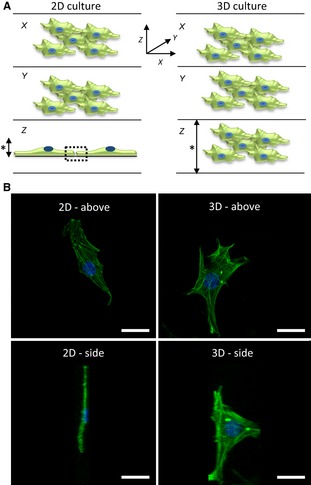Figure 1.

Impact of the physical environment on cell structure. (A) Visualisation of cells for each of the three dimensions (X,Y,Z). In simple terms, X and Y symbolize the length and width of a cell, and Z describes the height. In conventional 2D culture, cells grow as monolayers on a solid substrate; they flatten and possess a low vertical height (left). In contrast, cells cultured in a 3D model maintain a more natural 3D structure and possess more normal dimensions all round (right). Furthermore, the overall height (*) of a conventional 2D monolayer culture is relatively fixed, whereas that of a 3D culture is more versatile, depending on the 3D cell technology used, and can be built up to form multi‐layered tissue‐like structures. Interactions between adjacent cells cultured in 2D are restricted to the periphery of the cells within a single plane (left, dotted box), whereas in 3D models the scope of intercellular contact is all around. (B) Confocal images of a single fibroblast grown in 2D or 3D culture. The cell has been stained with phalloidin to visualize the primary structural elements of the F‐actin cytoskeleton and 4',6‐diamidino‐2‐phenylindole (DAPI) for the nucleus. The images show the shape of a typical cell when visualized from above (top panels) or from the side (bottom panels). Note how thin a cell can become when cultured on a flat substrate as in conventional 2D culture (left) compared with the more normal structure of a cell in a 3D culture model (right). Scale bars: 10 μm. (Images courtesy of Dr. F. Tholozan, Durham University).
